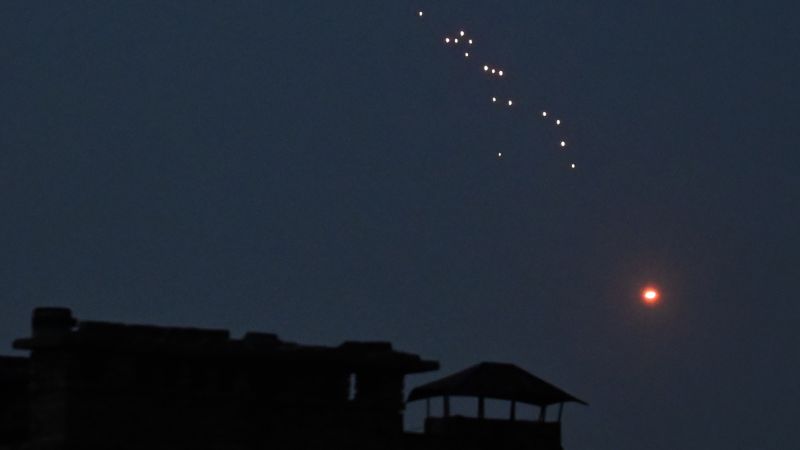Jets Capable Of Carrying Nuclear Weapons: A Closer Look

Welcome to your ultimate source for breaking news, trending updates, and in-depth stories from around the world. Whether it's politics, technology, entertainment, sports, or lifestyle, we bring you real-time updates that keep you informed and ahead of the curve.
Our team works tirelessly to ensure you never miss a moment. From the latest developments in global events to the most talked-about topics on social media, our news platform is designed to deliver accurate and timely information, all in one place.
Stay in the know and join thousands of readers who trust us for reliable, up-to-date content. Explore our expertly curated articles and dive deeper into the stories that matter to you. Visit Best Website now and be part of the conversation. Don't miss out on the headlines that shape our world!
Table of Contents
Jets Capable of Carrying Nuclear Weapons: A Closer Look at Global Arsenals
The chilling reality of nuclear-armed aircraft remains a significant factor in global geopolitics. The ability to deliver a nuclear payload swiftly and precisely represents a potent—and terrifying—deterrent. But which jets are capable of carrying these weapons of mass destruction, and what implications does this have for international security? This article delves into the capabilities of these aircraft, examining the key players and the ongoing implications for global stability.
The Elite Squad: Aircraft Designed for Nuclear Delivery
Several nations possess aircraft specifically designed or modified to carry nuclear weapons. These are not simply any fighter jet; they require specialized systems for safe transport and deployment, including robust navigation and communication systems and hardened structures to withstand the immense forces involved. Key players include:
-
United States: The U.S. Air Force relies heavily on the B-2 Spirit stealth bomber and the B-52 Stratofortress, both capable of carrying a range of nuclear payloads. Additionally, modified versions of the F-15 Eagle and F-16 Fighting Falcon fighters have served this purpose in the past, though their roles may be evolving. The future likely involves the B-21 Raider, a next-generation stealth bomber currently under development.
-
Russia: Russia maintains a substantial arsenal of nuclear-capable aircraft, including the Tupolev Tu-95MS Bear and Tupolev Tu-160 Blackjack bombers. These long-range bombers form a critical component of their nuclear triad. Modernization efforts continue to enhance their capabilities.
-
China: China's nuclear arsenal, while smaller than that of the U.S. or Russia, includes aircraft capable of delivering nuclear weapons. The Xian H-6K is a crucial element of their strategic bomber force, undergoing continuous upgrades to extend its range and payload capacity.
-
France & United Kingdom: Both France and the United Kingdom possess smaller, but still significant, nuclear forces, with aircraft playing a crucial role in their delivery systems. France uses the Rafale, while the UK utilizes the Tornado GR4 (although this is being phased out and replaced by the F-35).
Beyond the Bombers: The Significance of Carrier Aircraft
While strategic bombers are often the focus, it’s crucial to acknowledge that certain fighter jets, depending on their modification and the specific nuclear weapon, could be capable of carrying tactical nuclear weapons. This capability is generally kept highly classified. However, understanding the potential for such deployment is vital for assessing the risk of escalation in regional conflicts.
The Ongoing Arms Race and its Implications
The continued development and modernization of nuclear-capable aircraft highlight the ongoing global arms race. The implications are far-reaching, raising concerns about:
- Accidental War: The risk of accidental war or miscalculation due to technical malfunction or human error remains a persistent threat.
- Escalation: The presence of nuclear-capable aircraft increases the potential for rapid escalation of regional conflicts.
- Proliferation: The technology involved in creating and deploying nuclear weapons could potentially fall into the wrong hands.
Conclusion: A Necessary Vigilance
The existence of jets capable of carrying nuclear weapons necessitates a careful and constant assessment of global security. While these aircraft serve as a deterrent, their very existence underscores the urgent need for continued dialogue, arms control agreements, and a commitment to reducing nuclear proliferation. The future of global security hinges on responsible stewardship of these powerful and potentially devastating weapons. Staying informed about these advancements is crucial for understanding the complex dynamics of international relations. Learn more about nuclear non-proliferation efforts by visiting the website of the .

Thank you for visiting our website, your trusted source for the latest updates and in-depth coverage on Jets Capable Of Carrying Nuclear Weapons: A Closer Look. We're committed to keeping you informed with timely and accurate information to meet your curiosity and needs.
If you have any questions, suggestions, or feedback, we'd love to hear from you. Your insights are valuable to us and help us improve to serve you better. Feel free to reach out through our contact page.
Don't forget to bookmark our website and check back regularly for the latest headlines and trending topics. See you next time, and thank you for being part of our growing community!
Featured Posts
-
 Catawba County Tragedy Mass Shooting Leaves One Dead Many Wounded
Jun 02, 2025
Catawba County Tragedy Mass Shooting Leaves One Dead Many Wounded
Jun 02, 2025 -
 Equipementier Trop Visible Hailey Baptiste Et Le Reglement De Roland Garros
Jun 02, 2025
Equipementier Trop Visible Hailey Baptiste Et Le Reglement De Roland Garros
Jun 02, 2025 -
 Unexpected Chaos In Catania Norwegian Epic Cruise Ship Stranding Passengers
Jun 02, 2025
Unexpected Chaos In Catania Norwegian Epic Cruise Ship Stranding Passengers
Jun 02, 2025 -
 Watch Now Breaking Developments In Karen Read Murder Trial
Jun 02, 2025
Watch Now Breaking Developments In Karen Read Murder Trial
Jun 02, 2025 -
 Sudan Civil War A Photographers Shocking Images Reveal Brutal Reality
Jun 02, 2025
Sudan Civil War A Photographers Shocking Images Reveal Brutal Reality
Jun 02, 2025
Latest Posts
-
 Russia Launches Massive Air Strikes On Ukraine Poland Deploys Fighter Jets
Sep 22, 2025
Russia Launches Massive Air Strikes On Ukraine Poland Deploys Fighter Jets
Sep 22, 2025 -
 British Couples Son Freed By Taliban Joyful Reunion In Uk
Sep 22, 2025
British Couples Son Freed By Taliban Joyful Reunion In Uk
Sep 22, 2025 -
 Dealing With Loose Skin A Common Side Effect Of Weight Loss Drugs
Sep 22, 2025
Dealing With Loose Skin A Common Side Effect Of Weight Loss Drugs
Sep 22, 2025 -
 Car And Van Crash On A9 At Slochd Claims Two Lives Couple Named
Sep 22, 2025
Car And Van Crash On A9 At Slochd Claims Two Lives Couple Named
Sep 22, 2025 -
 London Fashion Week Romeo Beckhams Runway Walk And Dame Prues Show Stopping Outfit
Sep 22, 2025
London Fashion Week Romeo Beckhams Runway Walk And Dame Prues Show Stopping Outfit
Sep 22, 2025
